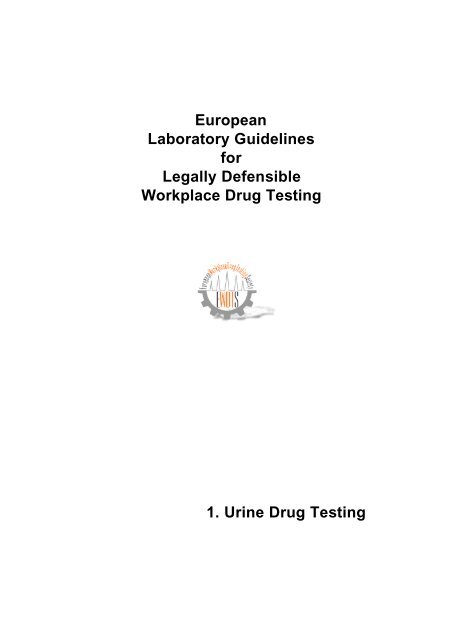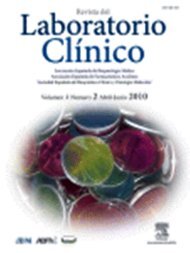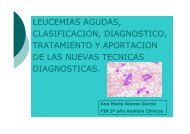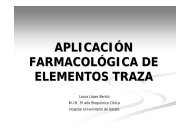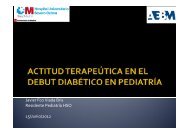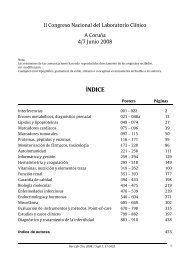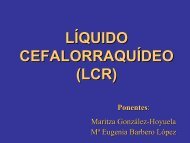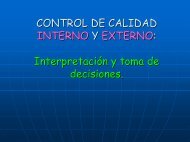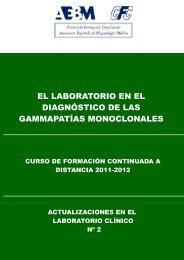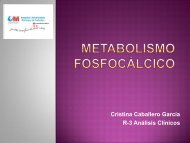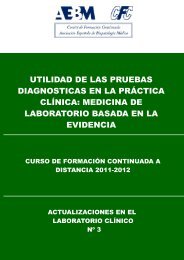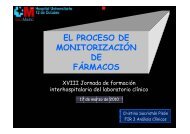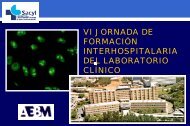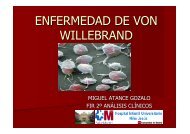Urine Drug Testing - ewdts
Urine Drug Testing - ewdts
Urine Drug Testing - ewdts
You also want an ePaper? Increase the reach of your titles
YUMPU automatically turns print PDFs into web optimized ePapers that Google loves.
European Laboratory Guidelines for Legally Defensible Workplace <strong>Drug</strong> <strong>Testing</strong>Version 1.0General1.1 Introduction1.1.1 These Guidelines represent an overview of the best practice forlaboratories providing workplace drug testing services withinEurope. They are based on the general principles that have beenestablished internationally. They are designed to ensure that theentire drug testing process is conducted to give accurate andreliable information about a donor's drug use.1.1.2 All laboratories that undertake legally defensible workplacedrug testing within Europe should use these guidelines as atemplate for accreditation.1.1.3 These Guidelines focus on urine, which is the usual specimenfor analysis. However the same general principles should beapplied for all specimen types.1.2 Objectives1.2.1 The guidelines are designed to1.2.1.1 Provide a minimum set of criteria for the providers ofworkplace drug testing services within Europe.1.2.1.2 Ensure that the processes undertaken are capable oflegal scrutiny.1.2.1.3 Provide safeguards to protect the specimen donors.1.2.1.4 Define for laboratories common quality assuranceand quality control criteria that are capable of beingaccredited by an external body.1.3 Scope1.3.1 These guidelines consider the three key stages of theworkplace drug testing process.1.3.1.1 Obtaining the specimen from the donor (specimencollection).1.3.1.2 Analysis of the sample for the presence of drugs(laboratory analysis).1.3.1.3 Review and interpretation of the analytical results(interpretation).© EWDTS 2002Page 5 of 39
European Laboratory Guidelines for Legally Defensible Workplace <strong>Drug</strong> <strong>Testing</strong>Version 1.01.4 Definitions1.4.1 Within this document the following definitions apply:1.4.1.1 Service Provider: The organisation contracted toprovide the drug testing service. This may be alaboratory, or a third party providing other elements ofthe service, and contracting with a laboratory.1.4.1.2 Laboratory: The facility providing the analyticalservices to detect drugs of abuse.1.4.1.3 Customer: The organisation requesting the drugtesting service.1.4.1.4 Donor: The person providing the specimen foranalysis.1.4.2 Further definitions relating to elements of the services areprovided in Section 8.1.5 Service Provision1.5.1 Where a service provider is contracted to deliver all thestages, they must ensure that the minimum criteria in thisdocument are met in all the key areas.1.5.2 In those instances where a customer may undertake somestages of the process within their own organisation (e.g.specimen collection or interpretation), the service providerhas a 'duty of care' to ensure that the customer understandsthe full implications of the drug testing process.1.5.3 The service provider does not have the authority to makedecisions regarding the fitness for work of any individualbeing tested. It is recommended that any issues related tofitness for work be referred to the company's medicalrepresentative.1.6 <strong>Drug</strong> <strong>Testing</strong> in Context1.6.1 It should be explained to any purchaser of a laboratory drugtesting service that drug testing should form part of an overalldrug policy, which the purchaser has agreed with hisemployees and should have in place before testing isinitiated.© EWDTS 2002Page 6 of 39
European Laboratory Guidelines for Legally Defensible Workplace <strong>Drug</strong> <strong>Testing</strong>Version 1.01.6.2 The service provider should have an effective company drugspolicy in place. The policy may include drug testing of thestaff involved in the analysis and reporting of workplace drugtesting results.1.7 Outline of drug testing process1.7.1 Collection1.7.2 The usual specimen collected for analysis is urine.1.7.3 <strong>Urine</strong> specimens for legally defensible drug testing need tobe collected under circumstances which respect the dignity ofthe individual whilst ensuring that the sample is freshly voided.1.7.4 Suitable records must be made when the specimen iscollected to prove that the specimen collected and the samplereceived by the laboratory is one and the same.1.7.5 This is the first link in the chain of custody process which,when reconstructed at a later date, can be used to prove thatthe final result belongs to the specimen collected.1.7.6 Analysis1.7.7 When the sample is received at the laboratory, checks on theintegrity of the sample are carried out. Providing the samplepasses the integrity checks a portion of the sample is takenand screened for the presence of drugs. If the screen resultsare all negative no further analysis is necessary.1.7.8 However if the screen tests carried out indicate the possiblepresence of a drug (above a predefined cut-off level) aconfirmation test to prove or disprove the presence of thedrug indicated by the screening test must be carried out onanother portion of the sample.1.7.9 When a negative result is obtained, either after the screen orconfirmation test, it can be reported to the customer. Positiveresults may require interpretation.1.7.10 Interpretation© EWDTS 2002Page 7 of 39
European Laboratory Guidelines for Legally Defensible Workplace <strong>Drug</strong> <strong>Testing</strong>Version 1.01.7.11 A laboratory positive result may be due to other reasons thanintake of illicit drugs (i.e medication (prescribed or over-thecounter)or to dietary causes).1.7.12 It requires interpretation that is best carried out by thelaboratory toxicologist in conjunction with a qualified medicalpractitioner who can consult both with the donor and thedonor’s medical practitioner.1.7.13 Record Keeping1.7.14 Suitable records must be made during the analytical processto prove that the sample received by the laboratory and thesample, about which the final report is written, are one and thesame.1.7.15 All samples which prove positive for the presence of drugs,and all records of the analytical process, must be kept for anagreed period of time to allow for any challenges to be maderegarding the findings.1.7.16 If the customer requires an independent toxicological review,the laboratory must make available, if requested, theanalytical data upon which it based its final report.1.8 Laboratory Security1.8.1 <strong>Drug</strong> testing laboratories must have a robust security systemto ensure that no unauthorised personnel gain access to thelaboratory processes or to areas where samples or recordsare stored.1.8.2 Unescorted access to these secured areas must be limited toauthorised individuals. The laboratory must maintain a recordthat documents the entry and exit of all visitors to the securedlaboratory areas.1.8.3 The laboratory must maintain a record of all staff who areauthorised to enter the secure laboratory areas. This list mustbe reviewed and updated on a regular basis.1.8.4 Sample bottles must be retained within the secure laboratoryarea until the disposal date agreed with the customer.© EWDTS 2002Page 8 of 39
European Laboratory Guidelines for Legally Defensible Workplace <strong>Drug</strong> <strong>Testing</strong>Version 1.02 Specimen collection2.1 Overview2.1.1 <strong>Urine</strong> specimens for legally defensible drug testing need tobe collected under circumstances which respect the dignity ofthe individual whilst ensuring that the sample is freshly voidedand has not been tampered with in any way.2.1.2 Suitable records must be made to prove that the specimencollected and the sample received by the laboratory are oneand the same.2.1.3 This is the first link in the chain of custody process which,when reconstructed at a later date, can be used to prove thatthe final result belongs to the sample collected.2.1.4 Where the customer takes responsibility for the collectionprocess, the service provider has a duty of care to ensure thatthese guidelines are understood.2.2 Personnel2.2.1 Specimens must be collected by suitably trained personnel(Collecting Officers) who have a thorough understanding ofthe principles of chain of custody.2.2.2 There are no specific qualifications, but collecting officersmust be able to provide evidence of their training, and/or theinstructions that they must follow during the collection process.2.3 Procedures2.3.1 The guidelines give the current best practice for the collectionof urine specimens for analysis. An example of a typicalspecimen collection protocol is given in Appendix A.2.3.2 The procedures must cover the following aspects:2.3.2.1 Privacy and security of the specimen collection site.2.3.2.2 Steps to ensure that the specimen is freshly voided.2.3.2.3 Steps to protect against tampering and adulteration.2.3.2.4 Identification of the individual giving the specimen.© EWDTS 2002Page 9 of 39
European Laboratory Guidelines for Legally Defensible Workplace <strong>Drug</strong> <strong>Testing</strong>Version 1.02.3.2.5 Evidence of the written informed consent of theindividual to the analysis of the specimen (anexample is given in Appendix B).2.3.2.6 Disclosure of recent medication, or evidence that theindividual was advised of the significance of recentmedication.2.4 Specimen Collection Kits2.4.1 The specimen collection kits should comprise the followingcomponents2.4.1.1 Chain of Custody Form.2.4.1.2 Barcode link between Chain of Custody Form andSample Bottles.2.4.1.3 Collection cup, demonstrably clean and unused.2.4.1.4 Temperature measurement device.2.4.1.5 At least two sample bottles, demonstrably clean andunused.2.4.1.6 Secure seal for each bottle.2.4.1.7 Packaging components that satisfy current mail andcourier regulations.2.5 Chain of Custody Form2.5.1 The minimum information required on the Chain of CustodyForm is2.5.1.1 Information identifying the donor.2.5.1.2 Date and time of collection.2.5.1.3 Name of testing laboratory.2.5.1.4 Names and signatures of all individuals who hadcustody of the sample during the collection process.© EWDTS 2002Page 10 of 39
European Laboratory Guidelines for Legally Defensible Workplace <strong>Drug</strong> <strong>Testing</strong>Version 1.03 Laboratory Organisation3.1 Personnel3.1.1 The Laboratory must be staffed by suitably qualifiedpersonnel. The key roles, qualifications and responsibilitiesare outlined below. It is acceptable for individuals to performmore than one role.3.1.2 The Laboratory must keep records that establish theindividual’s competency for the position(s) held. Theindividual’s file must include a CV showing qualifications andprevious employment experience, and training records for thecurrent tasks performed.3.1.3 All laboratory personnel must have received training inlaboratory safety to ensure compliance with relevantlegislation.3.2 Laboratory Head3.2.1 There must one person who has overall responsibility for theprofessional, organisational, educational, and administrativeactivities of the drug testing facility.3.2.2 This person is responsible for the day-to-day management ofthe drug testing laboratory.3.2.3 Some of the functions may be delegated to otherappropriately qualified personnel but the overall responsibilityfor any delegated functions will remain with the designatedLaboratory Head (typically the Laboratory Manager).3.2.4 Qualifications:3.2.4.1 At least a degree or degree equivalent in, forexample, the chemical or biological sciences ormedical technology.3.2.4.2 Training, experience and a thorough understanding ofchain of custody procedures, quality controlpractices, and the theory and practice of all analyticalmethods and procedures used in the laboratory.3.2.5 Responsibilities:© EWDTS 2002Page 11 of 39
European Laboratory Guidelines for Legally Defensible Workplace <strong>Drug</strong> <strong>Testing</strong>Version 1.03.2.5.1 Ensure that there are enough personnel withadequate training and experience to supervise andconduct the work of the drug-testing laboratory.3.2.5.2 Assure the continued competency of laboratorypersonnel by documenting their in-service training,reviewing their work performance, and verifying theirskills.3.2.5.3 Ensure that the laboratory has a manual of StandardOperating Procedures (SOPs), which is complete,up-to-date, and available for personnel performingtests, and followed by those personnel.3.2.5.4 Maintain a quality control program to assure theproper performance and reporting of all test results incompliance with SOPs.3.2.5.5 Maintain acceptable analytical performance for allcontrols and standards; for maintaining quality controltesting.3.2.5.6 Assure and document the validity, reliability,accuracy, precision, and performance characteristicsof each test and test system.3.2.5.7 Ensure that all remedial actions necessary tomaintain satisfactory operation and performance ofthe laboratory are taken (eg in response to qualitycontrol systems not being within performancespecifications, errors in result reporting or in analysisof external QA results), and that sample results arenot reported until all appropriate corrective actionshave been taken.3.2.5.8 Ensure that the results provided are accurate andreliable.3.3 Authorising Scientist3.3.1 A person responsible for the review and certification ofpertinent data and quality control results, prior to release ofanalytical results.3.3.2 Qualifications:© EWDTS 2002Page 12 of 39
European Laboratory Guidelines for Legally Defensible Workplace <strong>Drug</strong> <strong>Testing</strong>Version 1.03.3.2.1 At least a degree or degree equivalent in, forexample, the chemical or biological sciences ormedical technology.3.3.2.2 Training and experience in the theory and practice ofall methods and procedures used in the laboratory,including a thorough understanding of chain ofcustody procedures, quality control practices, andanalytical procedures relevant to the results that theindividual certifies.3.3.3 Responsibilities:3.3.3.1 Ensure that the results provided are accurate andreliable.3.4 Laboratory Analyst3.4.1 A person responsible for undertaking the day-to-dayanalytical procedures.3.4.2 Qualifications:3.4.2.1 Appropriate training and experience in the theory andpractice of the procedures used in the laboratory.3.4.3 Responsibilities:3.4.3.1 Maintenance of chain of custody.3.4.3.2 Day-to-day analytical procedures following SOPs.3.4.3.3 Remedial actions to be taken in response to testsystems being out of control limits or detectingaberrant test or quality control results.3.5 Toxicologist3.5.1 A person responsible for interpreting a positive analyticalresult for the customer or the customer’s designated MedicalReview Officer.3.5.2 Qualifications:3.5.2.1 At least a degree or degree equivalent in, forexample, the chemical or biological sciences/medicaltechnology and pharmacology/toxicology.© EWDTS 2002Page 13 of 39
European Laboratory Guidelines for Legally Defensible Workplace <strong>Drug</strong> <strong>Testing</strong>Version 1.04 Laboratory Analysis Procedures4.1 Summary4.1.1 When the sample is received at the laboratory, initial checkson the sample’s chain of custody and appearance are carriedout. If the sample passes these checks a portion of thesample is taken and goes through an initial screening test forthe presence of drugs. Further testing of sample validity mayalso take place at this point.4.1.2 If the screen results are all negative no further analysis isnecessary. However if the screen tests carried out indicatethe possible presence of a drug (above a pre-defined cut-offlevel) a confirmation test to prove or disprove the presence ofthe drug indicated by the screening test must be carried outon another portion of the sample.4.2 Chain of Custody4.2.1 Laboratories must use chain of custody procedures tomaintain control and accountability of samples from receiptthrough completion of testing, reporting of results, duringstorage, and continuing until final disposal of samples.4.2.2 Chain of custody records must be maintained on paper or incomputerized form.4.3 Receiving/Accessioning4.3.1 The laboratory should expect to receive at least two sealedsample bottles, and a chain of custody form, for everyspecimen collected.4.3.2 At least one of these (referred to, in this document, as the “B”bottle) must be retained unopened and stored in conditionsthat reflect the storage of the sample under test (referred to, inthis document, as the “A” bottle).4.3.3 When a sample is received in the laboratory:4.3.3.1 Its packaging must be examined for evidence oftampering in transit.© EWDTS 2002Page 15 of 39
European Laboratory Guidelines for Legally Defensible Workplace <strong>Drug</strong> <strong>Testing</strong>Version 1.04.10.2 Unless otherwise authorised in writing by the customer, drugtestinglaboratories must retain all samples confirmedpositive in properly secured long-term frozen storage for aminimum of 1 year.4.10.3 Within this one-year period the customer may request thelaboratory to retain the sample for an additional period oftime. If no such request is received, the laboratory maydiscard the sample after the end of 1 year, except that thelaboratory shall be required to maintain any samples known tobe under legal challenge for a further agreed period.4.11 Records4.11.1 The laboratory must maintain and make available for anagreed period, documentation of all aspects of the testingprocess involved in the generation of a positive result.4.11.2 The required documentation must include4.11.2.1 Training records on all individuals authorised tohave access to samples.4.11.2.2 Chain of custody forms.4.11.2.3 Quality assurance/quality control records.4.11.2.4 Procedure manuals.4.11.2.5 All test data (including calibration curves and anycalculations used in determining test results).4.11.2.6 Reports.4.11.2.7 Records of performance testing and computergenerateddata.4.11.3 The laboratory will be required to maintain documents for anysample under legal challenge for a further agreed period.4.11.4 Records containing details of individuals will be dealt with inline with relevant Data Protection Legislation.© EWDTS 2002Page 20 of 39
European Laboratory Guidelines for Legally Defensible Workplace <strong>Drug</strong> <strong>Testing</strong>Version 1.05 Quality Assurance and Quality Control5.1 Quality assurance5.1.1 <strong>Drug</strong> testing laboratories must have a quality system whichencompasses all aspects of the testing process including butnot limited to5.1.1.1 Sample receipt.5.1.1.2 Chain of custody.5.1.1.3 Security and reporting of results.5.1.1.4 Screen and confirmation testing.5.1.1.5 Certification of calibrators and controls.5.1.1.6 Validation of analytical procedures.5.1.2 Quality assurance procedures shall be designed,implemented and reviewed to monitor the conduct of eachstep of the testing process.5.1.3 The standard set by ISO 17025 must apply.5.1.4 The laboratory must be accredited for Workplace <strong>Drug</strong><strong>Testing</strong> by a recognised external accreditation body workingto these European guidelines.5.2 Quality Control5.2.1 Laboratory calibrators and controls shall be prepared usingeither certified drug reference materials or standard solutionsobtained from commercial manufacturers.5.2.2 The laboratory must retain records to demonstrate that allcalibrators and controls are traceable back to primarystandards (if available).5.2.3 The calibrators and controls shall be properly labelled as tocontent and concentration.5.2.4 All standards (eg pure reference materials, stock standardsolutions, purchased standards) shall be labelled with thefollowing dates:5.2.4.1 When received (if applicable).5.2.4.2 When prepared or opened.© EWDTS 2002Page 21 of 39
European Laboratory Guidelines for Legally Defensible Workplace <strong>Drug</strong> <strong>Testing</strong>Version 1.05.2.4.3 When placed in service.5.2.4.4 Expiration date.5.2.5 All data acquired on control samples must be recorded insuch a way as to facilitate interpretation of control results andtrends.5.3 Screen Tests5.3.1 These are the minimum requirements for the suitable controlof all screen tests.5.3.2 A system suitability check must be carried out prior to theanalysis of samples.5.3.3 Assays must be calibrated at least once per week.5.3.4 Control samples at concentrations of approximately 25%below and above the cut off concentration for each drug groupmust be included in every batch of samples. These must besourced independently from calibrators.5.3.5 Quality control samples must comprise at least 5% of the totalnumber of samples in each batch being analysed.5.4 Confirmation tests5.4.1 These are the minimum requirements for the suitable controlof all confirmation tests:5.4.2 A system suitability check must be carried out prior to theanalysis of samples.5.4.3 A calibration curve must include at least 3 calibration pointsand a blank. The calibration points must bracket the cut-offconcentration.5.4.4 Quantitative analysis must be carried using internalstandardisation. The use of deuterated internal standards,when obtainable, is recommended.5.4.5 An independently prepared control sample at a concentrationof approximately the cut off concentration for each drug mustbe included in every batch of samples analysed.© EWDTS 2002Page 22 of 39
European Laboratory Guidelines for Legally Defensible Workplace <strong>Drug</strong> <strong>Testing</strong>Version 1.05.4.6 Checks on assay drift and carry-over must be performed atintervals within each assay.5.4.7 The retention time of a compound shall be within ±3 seconds(or ±2%, whichever is the lower) of the retention time of thecalibration standard.5.4.8 If using selected ion monitoring or its equivalent5.4.8.1 a minimum of three specific and significant ions shallbe used.5.4.8.2 No ions less than m/z 50 are to be used.5.4.8.3 The common low mass ions, m/z 58, 86, 91, 105shall not be considered as specific but may beincluded in addition to any other specific ion.5.4.8.4 The ratio of these ion intensities in the unknown shallbe within 20% of corresponding ratios in theextracted reference material.5.4.8.5 If using deuterated internal standards, two specificand significant ions shall be used.5.4.9 If using full scan to identify the compounds5.4.9.1 the scan range shall be from m/z 50 to a value abovethat expected for the molecular weight of thecompound or its derivative.5.4.9.2 All significant ions present in the calibration standardshall also be present in the sample.5.4.9.3 the ratio of the ion intensities of the significant ions inthe sample must be within 30% of the correspondingion intensities in the extracted calibration standard.5.4.9.4 The presence of significant ions in the spectrum ofthe unknown that are not in the spectrum of thecalibration standard is acceptable provided that theirpresence can be explained and discounted.5.5 Quality assessment5.5.1 The laboratory must take part in an appropriate externalquality assessment scheme. Performance outside the criterialaid down by the scheme should be rectified.© EWDTS 2002Page 23 of 39
European Laboratory Guidelines for Legally Defensible Workplace <strong>Drug</strong> <strong>Testing</strong>Version 1.05.6 Sub-contracting5.6.1 <strong>Drug</strong> testing laboratories should perform all laboratory workwith their own personnel and equipment. Interlaboratorytransfer of samples is performed with strict adherence tochain of custody procedures. The sub-contracted laboratorymust be accredited by a recognised external accreditingbody and working to these guidelines.© EWDTS 2002Page 24 of 39
European Laboratory Guidelines for Legally Defensible Workplace <strong>Drug</strong> <strong>Testing</strong>Version 1.06 Challenges to <strong>Drug</strong> Test ResultsIn situations where there is a challenge to the results of a positivedrug test result, the following guidelines must be used.6.1.1 The B sample should be released for analysis to a drugtestinglaboratory accredited by a recognised externalaccrediting body and working to these guidelines.6.1.2 This release requires authorisation from the customer and thedonor.6.1.3 The release must be supported by a chain of custody that canwithstand legal scrutiny and a copy of the quantitative resultobtained on the corresponding A sample.6.1.4 The original laboratory must retain the residue of the originalsample and its containers, so that they can be compared withthe B sample at a later date, if required.6.1.5 All laboratories that undertake B sample testing must be ableto demonstrate that they can accurately determine theconcentration of a drug or metabolite at 50% of therecommended confirmation cut-off concentration listed inAppendix B.6.1.6 It is recommended that the laboratory that receives the Bsample must perform a confirmation analysis only for thosedrugs identified to it, within 10 working days of receipt.6.1.7 The final report on the B sample must say either that therewas no drug found, or a named drug was found at a level thatis either consistent or inconsistent with the level in thecorresponding A sample.6.1.8 The determinant as to whether a drug is found or not is thelimit of quantitation quoted for the method used to confirm thepresence of the drug.6.1.9 Confirmation cut-off levels are not to be used as thedeterminant.6.1.10 There must be no comment on the final report that stateswhether the sample is positive or negative.© EWDTS 2002Page 25 of 39
European Laboratory Guidelines for Legally Defensible Workplace <strong>Drug</strong> <strong>Testing</strong>Version 1.07 Interpretation of Results7.1.1 An analytical positive result may be due to medication(prescribed or over-the-counter) or to dietary causes. Anessential part of the drug testing process is the final review ofpositive analytical results.7.1.2 The interpretation is best carried out by a qualified medicalpractitioner (Medical Review Officer - see Appendix G) whocan consult with the laboratory toxicologist, the donor, and thedonor's medical practitioner.7.2 Toxicology Review7.2.1 A toxicologist must be available to advise the customer and/orMedical Review Officer regarding queries with results.7.2.2 The toxicologist cannot issue a negative report for a positiveanalytical result even if the test result is likely to be due to theuse of declared medication.© EWDTS 2002Page 26 of 39
European Laboratory Guidelines for Legally Defensible Workplace <strong>Drug</strong> <strong>Testing</strong>Version 1.08 DefinitionsFor purposes of these guidelines the following definitions have beenadopted:AdulterationAliquotAuthorisingScientistCalibratorChain ofCustodyChain ofCustodyFormCollectingofficerCollectionSee TamperingA fractional part of a sample used for testing. It istaken as a sample representing the whole sample.A person who reviews all pertinent data and qualitycontrol results in order to attest to the validity of thelaboratory's test reports.A solution of known concentration used to calibratea measurement procedure or to compare theresponse obtained with the response of a testsample/sample. The concentration of the analyteof interest in the calibrator is known within limitsascertained during its preparation. Calibratorsmay be used to establish a calibration curve over arange of interest.Procedures to account for each specimen bytracking its handling and storage from point ofcollection to final disposal. These proceduresrequire that the donor identity is confirmed and thata chain of custody form is used from time ofcollection to receipt by the laboratory. Within thelaboratory appropriate chain of custody recordsmust account for the samples until disposal.A form used to document the procedures from timeof collection until receipt by the laboratory.A person trained to collect specimens from donors.A place where individuals present themselves for© EWDTS 2002Page 27 of 39
European Laboratory Guidelines for Legally Defensible Workplace <strong>Drug</strong> <strong>Testing</strong>Version 1.0SiteConfirmationTestCut-offDonorNegativeresultPositiveresultQualitycontrolsampleMedicalReviewOfficer (MRO)Samplethe purpose of providing a specimen for analysis.An analytical procedure to identify and quantify thepresence of a specific drug or metabolite which isindependent of the initial test and which uses adifferent technique and chemical principle from thatof the screen test in order to ensure reliability andaccuracy.A concentration level set to determine whether thesample is positive or negative for the presence of adrug.The individual from whom a urine specimen iscollected.A result reported by laboratory that indicates thateither no drug is present in the sample or that anydrug present is below the cut-off.A result reported by the laboratory as positivemeans that there is conclusive evidence that a drugis present in the sample tested at level greater thanor equal to the confirmation cut off concentration.A sample used to evaluate whether or not ananalytical procedure is operating within pre-definedtolerance limits.A medical physician responsible for receivinglaboratory results from the drug-testing laboratorywho has knowledge of substance abuse and hasappropriate training or experience to interpret andevaluate an individual's positive test result, in lightof declared information.A representative portion of a specimen submittedto a laboratory for testing.Screen TestA test to eliminate negative samples from furtherconsideration and to identify the presumptively© EWDTS 2002Page 28 of 39
European Laboratory Guidelines for Legally Defensible Workplace <strong>Drug</strong> <strong>Testing</strong>Version 1.0SpecimenStandard (1)positive samples that require confirmation testing.The portion of (normally) urine that is collected froma donor.A reference material of known purity or a solutioncontaining a reference material at a knownconcentration.Standard (2) An agreed protocol or procedure (eg ISO 17025)StandardOperatingProcedure(SOP)TamperingA written document giving the detailed steps to befollowed when undertaking a particular task (e.g.the analysis of a given drug in a urine sample).Any process by which an individual knowinglyinterferes with (or attempts to interfere with) theprocesses of specimen collection, transport oranalysis with the intention of avoiding a legitimatetest result. The actions undertaken can include (butare not limited to) the addition of water or foreignsubstances to the specimen, specimensubstitution, damaging bottle seals or packagingand the deliberate consumption of interferingsubstances or copious volumes of water prior tospecimen collection.© EWDTS 2002Page 29 of 39
European Laboratory Guidelines for Legally Defensible Workplace <strong>Drug</strong> <strong>Testing</strong>Version 1.0Appendix A<strong>Urine</strong> Collection Procedures - an example of a typical protocolappropriate for [country]I) Collection SiteProcedures shall provide for a designated collection site to be secure.During the collection process the collection site must be dedicated solelyto drug testing and comply with all local health and safety requirements.II)Chain of CustodyDuring the collection process chain of custody forms will be completedfully by the collection officer and donor.III)Access to Authorised Personnel OnlyOnly authorised personnel shall be permitted in any part of thedesignated collection site when urine samples are being collected orstored.IV)Identification of the donor.When a donor arrives at the collection site, the collection officer willrequest that the donor presents photographic identification. If the donordoes not have proper photographic identification, the collection officer willobtain a positive identification of the donor by an authorised supervisor ormanager within the parent organisation. If the donor's identity cannot beestablished, the collection officer will not proceed with the collection.V) PrivacyProcedures for collecting urine specimens shall allow individual privacyduring urination.VI)Integrity of the SpecimenThe collection officer must adopt procedures to minimise the risk ofadulteration of the specimen during the collection procedure. Thefollowing minimum precautions shall be taken to ensure thatunadulterated specimens are obtained and correctly identified:(a) To deter the dilution of specimens at the collection site, toilet watercolouring agents should be placed in toilet tanks wherever accessibleor in the toilet bowl, so the reservoir of water in the toilet bowl alwaysremains coloured. Any other sources of water in the enclosurewhere urination occurs (e.g. taps, shower) will be secured prior tocollection.(b) The collection officer will ask the donor to remove any unnecessaryouter garments such as a coat or jacket that might conceal items or© EWDTS 2002Page 30 of 39
European Laboratory Guidelines for Legally Defensible Workplace <strong>Drug</strong> <strong>Testing</strong>Version 1.0substances that could be used to tamper with or adulterate thedonor's urine specimen. The collection officer will ensure that allpersonal belongings such as a purse or briefcase remain with theouter garments.(c) The donor will be instructed to wash and dry his or her hands prior tourination with inspection of the hands afterwards by the collectionofficer.(d) After washing hands, the donor will remain in the presence of thecollection officer and will not have access to any unregulated sourceof water, soap dispenser, cleaning agent, or any other materials thatcould be used to adulterate the specimen.(e) The collection officer will give the donor a clean specimen container.The donor may provide his/her specimen in the privacy of a toiletcubicle or otherwise partitioned area that allows for individual privacy.The collection officer will remain outside the cubicle until thespecimen is collected. The donor will be instructed not to flush thetoilet until the specimen is handed to the collection officer.(f) The collection officer will note any unusual behaviour of the donor onthe chain of custody form.(g) Upon receiving the specimen from the donor, the collection officerwill:• Check the volume of urine in the specimen container and• Check the temperature of the urine specimen. (The temperaturemeasuringdevice used must accurately reflect the temperatureof the specimen and not contaminate the specimen. The timefrom urination to temperature measurement is critical and in nocase should exceed 4 minutes).• Inspect the specimen to determine its colour and appearance forany signs of contaminants. Any unusual findings will be noted onthe chain of custody form.If the volume is approx. 30 millilitres (ml) or more and thetemperature is within the acceptable range of 32° -38°C, thecollection officer will proceed with step (h) below.If the volume is less than 30 ml, the specimen will be discarded and asecond specimen will be collected. The donor may be offered areasonable amount of liquid to drink for this purpose (e.g., 250ml ofwater every 30 min, but not to exceed a maximum of 1 litre). In thesecircumstances a donor should normally be able to provide a 30 mlurine specimen within 2 to 3 hours. If the donor fails to provide a© EWDTS 2002Page 31 of 39
European Laboratory Guidelines for Legally Defensible Workplace <strong>Drug</strong> <strong>Testing</strong>Version 1.0specimen within this time period the collecting officer will contact theappropriate authority to obtain guidance on the action to be taken.If the temperature of the urine specimen is outside the acceptablerange of 32° -38°C, a second specimen will be collected (as above).A temperature outside of the range is a reason to be suspicious thatthe donor may have altered or substituted the specimen. If there isany reason to believe (temperature outside of range, visiblecontamination etc) that a donor may have adulterated, diluted, alteredor substituted the specimen, another specimen will be obtained assoon as possible and both specimens will be forwarded to thelaboratory for testing.(h) Both the donor and the collection officer will keep the specimencontainer /specimen bottles in view at all times prior to the urinespecimen being sealed and labelled.(i) The specimen is split into a minimum of two specimen bottles.When the specimen is transferred from the specimen container tothe specimen bottles, it will be poured and the collection officer willrequest the donor to observe the transfer of the specimen and theattachment of the tamper-evident seal/tape on the bottles. Thetamper-evident seal ensures that any tampering with the specimenwill be evident to laboratory personnel during the laboratory receipt.(j) Direct contact tests can only be carried out on the residue of thespecimen after the sample has been split and sealed into specimenbottles.(k) A minimum of two sealed specimens together with the correspondingchain of custody documentation in a tamper evident container mustbe dispatched to the laboratory. One bottle will be used for the drugtest while the second bottle will remain sealed at the analyticallaboratory in case the donor wishes to challenge a positive result.(l) At an appropriate time after the urine specimen has been collectedand sealed into the transport bottles the collection officer will invitethe donor to wash his/her hands.(m) The specimen bottle will have an identification label that contains at aminimum the date, the donor's specimen number and the donor’ssignature/initials. The collection officer will enter all information onthe chain of custody form to identify the origin of the specimen. Bothspecimen bottles and all pages of the chain of custody will be labelledat the time of collection with a unique identifier.(n) The collection officer will ask the donor questions relating to thedrugs and medicines consumed within a minimum of 14 days prior tothe provision of the urine specimen. These questions will be specific© EWDTS 2002Page 32 of 39
European Laboratory Guidelines for Legally Defensible Workplace <strong>Drug</strong> <strong>Testing</strong>Version 1.0and wide ranging covering areas such as medications prescribed ordispensed by a doctor, dentist or hospital department and over-thecounterpreparations.(o) The donor will be asked to read and sign a statement on the chain ofcustody form certifying that the specimen identified on the form wasin fact the specimen provided by the donor and giving informedconsent for the work to be undertaken. Appendix B gives an exampleof a Donor’s Statement of Informed Consent.(p) The collection officer will complete the specimen chain of custodyform and package with the urine specimen ready for dispatchtogether to the analytical laboratory as soon as possible. If thespecimen is not dispatched at once, the collection officer duringstorage prior to dispatch must give appropriate consideration to thetemperature and security of the specimens, It is advised that thespecimens should be stored at 4°C (do not freeze) when everpossible.(q) Other pages of the chain of custody form will be given/forwarded tothe appropriate persons.(r) The collection officer and the donor will be present throughout theprocedures outlined in the paragraphs of this section.VII) Transportation to Laboratory(s) Collection officers will arrange to dispatch the collected specimens tothe drug-testing laboratory. The specimens will be placed incontainers designed to minimise the possibility of damage duringshipment. Since specimens and the corresponding documents aresealed in packages that would indicate any tampering during transitto the laboratory by couriers, carriers, and postal services there is norequirement for documented chain of custody procedures for thetransport of the package.© EWDTS 2002Page 33 of 39
European Laboratory Guidelines for Legally Defensible Workplace <strong>Drug</strong> <strong>Testing</strong>Version 1.0Appendix BExample of a Donor’s Statement of Informed Consentappropriate for [country]I confirm that I have provided a freshly voided urine specimen to thespecimen collector. I have observed the specimen being placed andsealed in the specimen bottles and I confirm that the information onthis form and on the specimen labels is correct. I hereby givepermission for a minimum of two sealed specimen containers to besent to the laboratory and I consent that they be tested for evidenceof drug use and for tests to be carried out to confirm the validity ofthe sample. Furthermore, I understand that the results will becommunicated confidentially to the employer or a designatedrepresentative.I consent to the above.Donor’s Name (BlockCapitals)Donor’s Signature:Date:Donor’s identifier on thespecimen labels (if differentfrom above)© EWDTS 2002Page 34 of 39
European Laboratory Guidelines for Legally Defensible Workplace <strong>Drug</strong> <strong>Testing</strong>Version 1.0Appendix CSome examples of flaws in the Chain of Custody1. Barcode mismatch or absent2. No documentation received with the sample3. No written consent to test from the donor4. Seals broken or tampered with on any bottle5. No seals6. Only 1 sample received7. Insufficient sample for complete analysis8. Leaking sample© EWDTS 2002Page 35 of 39
European Laboratory Guidelines for Legally Defensible Workplace <strong>Drug</strong> <strong>Testing</strong>Version 1.01. ImmunoassayAppendix DAcceptable Screening Techniques2. Gas Chromatography3. High Pressure Liquid Chromatography4. Enzyme-based assays5. Any chromatographic technique hyphenated to massspectrometry.© EWDTS 2002Page 36 of 39
European Laboratory Guidelines for Legally Defensible Workplace <strong>Drug</strong> <strong>Testing</strong>Version 1.0Appendix ERecommended maximum cut-off concentrations for Screening Testsappropriate for [country]Screen TestCut-Off Concentration (ng/ml)Amphetamine group 500Benzodiazepines group 200Cannabis metabolites 50Cocaine metabolites 300Opiates (total) 300Methadone or metabolites 300Barbiturates 200Phencyclidine 25Buprenorphine ormetabolitesLSD or metabolites 1Propoxyphene ormetabolites5300Methaqualone 300These recommended cut-off values may be subject to changes asadvances in technology or other considerations warrant identificationof these substances at other concentrations.Cut-off levels for substances not indicated in Appendix E will need tobe agreed with the customer taking into account the performance ofthe assays to be used.© EWDTS 2002Page 37 of 39
European Laboratory Guidelines for Legally Defensible Workplace <strong>Drug</strong> <strong>Testing</strong>Version 1.0Appendix FRecommended cut-off concentrations for confirmation testsappropriate for [country]Confirmation TestAmphetaminesCut-Off Concentration (ng/ml) (Total)Amphetamine 200Methylamphetamine 200MDA 200MDMA 200MDEA 200Other members of the amphetamine group 200BenzodiazepinesTemazepam 100Oxazepam 100Desmethyldiazepam 100Others members of the benzodiazepinegroup by agreement with the customer.Opiates (total)Morphine 300Codeine 300Dihydrocodeine 3006-Monoacetylmorphine 10Cannabis metabolite(11-nor-Ä 9 -tetrahydrocannabinol-9-carboxylicacid.)Cocaine metabolite (benzoylecgonine) 150Methadone or metabolites 250Barbiturates group 150Phencyclidine 25Buprenorphine or metabolites 5LSD or metabolites 1Propoxyphene or metabolites 300Methaqualone 30015© EWDTS 2002Page 38 of 39
European Laboratory Guidelines for Legally Defensible Workplace <strong>Drug</strong> <strong>Testing</strong>Version 1.0Appendix GMedical Review(a) The Medical Review Officer (MRO) is a medical physician withresponsibility for interpreting laboratory results.(b) A medical physician will have greater access to medical recordsthan a toxicologist and may therefore be in a better position toprovide interpretation of positive analytical results.(c) The MRO must have specialist knowledge of and training in• Specimen collection procedures.• Analytical procedures.• Chain of Custody.• Alternative explanations for positive analytical results.(d) The MRO can issue a negative report for a positive analyticalresult if the test result is likely to be due to the use of declaredmedication, or a valid alternative explanation has been found.(e) The service provider may provide access to an independentmedical review service.© EWDTS 2002Page 39 of 39


